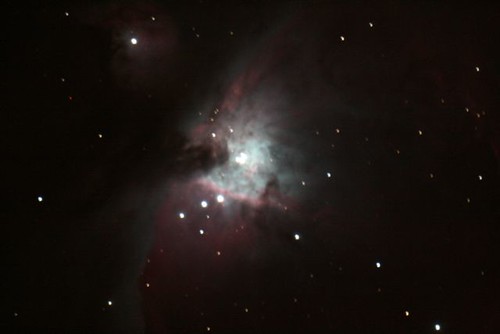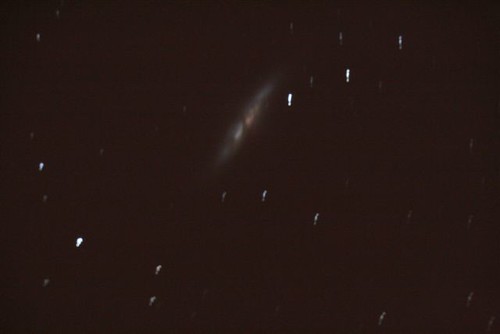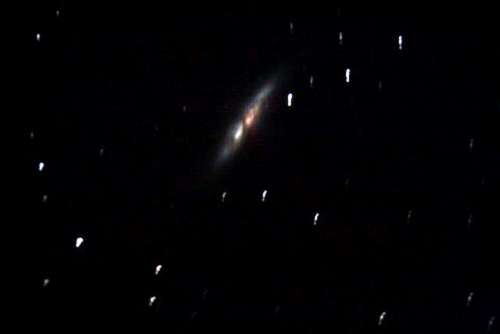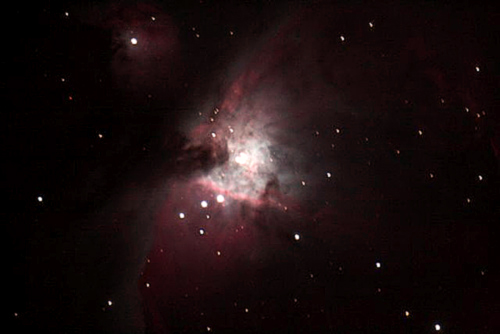Page 1 of 1
Catch of the day images
Posted: Tue Dec 11, 2007 11:57 pm
by Conn Buckley



I should really call this 'catch of the night' -- these images were taken last night and a very frosty night it was. This was really the first chance I got to try my hand at imaging some of the well known image targets and there are far better examples available.
The big satisfaction is trying this is that the results are 'your very own'.
All the images were taken with a Canon EOS 400D digital camera attached to a Meade LX200R 10" telescope. I do not have an equatorial mount and hence these images are quite short exposures in order to avoid 'trailing'.
The star cluster is called M37 (NGC 2099) and this is the largest and richest cluster in the constellation of Auriga containing about 150 stars and lies circa 4,400light years away. In binoculars it appears as a hazy unresolved patch but in a 100mm telescope it resolves into a sparkling field of faint stardust with a bright orange star at the centre. It looks stunning in the eyepiece of my scope. This is a 45" exposure and star trailing is just starting.
The Great Orion Nebula known as M 42, M 43 (NGC 1976, NGC 1982)image is a 55" exposure -- again star trailing is beginning and yet you can still make out the 4 stars of the Trapezium. The longer the exposure the more you pick up the 'redness' of this gigantic nebula of gas and dust. It is of course in the constellation of Orion and even with the naked eye you can see this 'nebula' as a hazy patch. It is 15 light years in diameter and lies 1,500 l.y. away from Earth. New stars are being formed here.
The other image is of M 82 (NGC 3034) in the constellation of Ursa Major. It is an 'edge on' spiral galaxy and is interacting with with a huge cloud of dust. This is a 5 minute exposure and hence the star trails. Considering this galaxy is a staggering 10 million light years away to get any image is pleasing.
Posted: Wed Dec 12, 2007 8:41 am
by John O'Mahony
Well done Conn. Nice images.

I have yet to try my hand at DSO imaging (no camera) but I'm tempted now.
It would be fun to have an "imaging night" out on the hill over Christmas, especially with Mars being so well placed. Do you think you would be able to lug the 10" out sometime?
john
Posted: Thu Dec 13, 2007 12:09 am
by Frank Ryan
Great shots Conn.
The Orion nebula looks very well.
The colour is very good and you did well not to over expose the trapizium.
Please post up some more if you have them!
Posted: Thu Dec 13, 2007 10:29 am
by Conn Buckley
Thanks for the encouraging comments. I have to think hard about the next steps --- seems to me that they would all be expensive.
John, I have hesitated at the prospect of transporting the 10" up to the hill, mainly for the weight /car space problems but i like your suggestion of a night devoted to trying out imaging. know that Frank and Dave are well advanced with imaging but I feel that there is a huge amount of fun 'on the road to discovery' so to speak.
Posted: Thu Dec 13, 2007 7:01 pm
by Dave Lillis
All great images Conn, its interesting to see the field rotation on M82, have you pushed any of these images through photoshop ??
Posted: Thu Dec 13, 2007 9:58 pm
by Conn Buckley
Dave, thanks . Nope I do not have photoshop, only Microsoft Office Picture Manager that has basic capability to change the brightness, contrast etc. and Photoimpression which is much the same.
What could Photoshop do to improve the image? Care to do a demo of 'before' and 'after on M82?
Posted: Thu Dec 13, 2007 10:56 pm
by Dave Lillis
Hi Conn, I'm glad you asked, i was thinking that M42 has alot of hidden detail in there, I think M82 could do with a bit higher S/N ratio, thats accomplished by a longer exposure,
I ran them through some very simple and quick (60 seconds) processing in photoshop.


Colour balance is a personal taste thing, I usually prefer to see M42 with a good red hue, I've also sharpened it a bit, M82 has some good colour in there, its a tiny bit fuzzy, also in that shot you can see that your collimation is a tiny bit out, the centre of rotation should be in the centre of the image, its a slight bit out, it makes no difference to the image, its just something to know.
Posted: Thu Dec 13, 2007 11:09 pm
by Dave Lillis
Conn Buckley wrote:Thanks for the encouraging comments. I have to think hard about the next steps --- seems to me that they would all be expensive.
I have hesitated at the prospect of transporting the 10" up to the hill, mainly for the weight /car space problems
I cant help you with the car issue but if you ever need help lifting the scope in and out of the car at home, I'd be well able to give you a hand.
Conn Buckley wrote: but i like your suggestion of a night devoted to trying out imaging.
A great idea, what would you have in mind exactly?
Posted: Fri Dec 14, 2007 7:55 pm
by Conn Buckley
Dave, Jeepers,

I did not think that much could be achieved with photoshop. I am very impressed. Thanks a million for that. Every night I bring out the scope I promise myself that I will concentrate on understanding the procedure to, not alone detect the collimation being out, but to manage to adjust it alone. I know it is tricky, but like the imaging, you have to just go and do it . We get so few opportunities to observe that when I do get out all my good intentions simply go out the window and I get in as much observing as possible.
John suggested a night of imaging and I thought what a good idea. I have not thought out what exactly this would consist of but maybe if John or indeed anybody else wanted to attach my camera to their own scope they would be more than welcome. It would mean getting the right T-adapter for the particular scope but I think that would be an inexpensive step to try out their scope for imaging. John, perhaps you might have some ideas yourself and we can work towards organising.
Posted: Fri Dec 14, 2007 9:46 pm
by John O'Mahony
Hi guys
My thought was that during the next available observing session (weather permitting

) we should bring along the webcams/laptops and if anyone has a camera bring it along. Mars will be very well placed for imaging and its a good time of year for bright DSO's. If 220V power is available this could run the laptops. Personally I'd love to see how imaging is done.
Just a thought.
Posted: Sat Dec 15, 2007 11:44 pm
by Dave Lillis
John, This is a great idea,
I'll arrange with Brendan to have power there.
I'll let you know how we stand on that before the next observing session.
Posted: Sun Dec 16, 2007 8:00 pm
by Frank Ryan
I'm in!
Dave, do you think we can have a go at Mars with the the webcam thru the 20'' up there?
Posted: Mon Dec 17, 2007 1:15 am
by Dave Lillis
Absolutely, !!, that's one of my goals for the winter, lets hope we get a few clear nights this week coming !
Posted: Tue Dec 18, 2007 10:41 pm
by Conn Buckley
Dave Lillis wrote:M82 has some good colour in there, its a tiny bit fuzzy, also in that shot you can see that your collimation is a tiny bit out, the
Dave, Been away for a few days -- I was thinking about this and remembered that I never locked the mirror for any of those images. Could this account for the rotation/collimation result I wonder?
Posted: Wed Dec 19, 2007 12:14 am
by Dave Lillis
It is possible, mirror flop can cause some weird stars in images. The only way to find out is give it a go again with the mirror locked.




